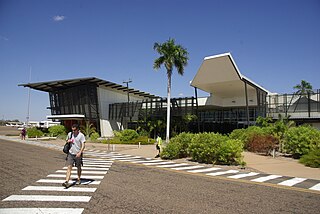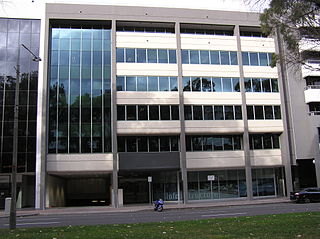Related Research Articles

Pipeline transport is the long-distance transportation of a liquid or gas through a system of pipes—a pipeline—typically to a market area for consumption. The latest data from 2014 gives a total of slightly less than 2,175,000 miles (3,500,000 km) of pipeline in 120 countries of the world. The United States had 65%, Russia had 8%, and Canada had 3%, thus 75% of all pipeline were in these three countries.

Cairns Airport is an international airport in Cairns, Queensland, Australia. Formerly operated by the Cairns Port Authority, the airport was sold by the Queensland Government in December 2008 to a private consortium. It is the seventh busiest airport in Australia. The airport is located 2.3 nautical miles north northwest of Cairns or 7 kilometres (4.3 mi) north of the Cairns central business district, in the suburb of Aeroglen. The airport lies between Mount Whitfield to the west and Trinity Bay to the east.

Gold Coast Airport is an international Australian airport located at the southern end of the Gold Coast and approximately 90 km (56 mi) south of center of Brisbane, within South East Queensland agglomeration. The entrance to the airport is situated in the suburb of Bilinga near Coolangatta. The runway itself cuts through the state borders of Queensland and New South Wales. During summer, these states are in two different time zones. The Gold Coast Airport operates on Queensland Time all year round.

The Melbourne rail network is a passenger and freight train system in the city of Melbourne, Victoria, Australia. It is the core of the larger Victorian railway network, with links to both intrastate and interstate systems. A large suburban passenger network centred on the CBD also operates, with a limited degree of segregation from longer-distance passenger and freight trains.

TC Energy Corporation is a major North American energy company, based in the TC Energy Tower building in Calgary, Alberta, Canada, that develops and operates energy infrastructure in Canada, the United States, and Mexico. The company operates three core businesses: Natural Gas Pipelines, Liquids Pipelines and Energy.

Darwin International Airport is the busiest airport serving the Northern Territory and the tenth busiest airport in Australia. It is the only airport serving Darwin.

Albany Regional Airport is an airport serving Albany, Western Australia. It is located 6 nautical miles northwest of Albany just off Albany Highway and operated by the City of Albany.

Ergon Energy Network is a subsidiary company of Energy Queensland Limited (EQL) a Government owned corporation owned by the Government of Queensland. It distributes electricity to around 763,000 customers across Queensland, excluding South East Queensland through a distribution network regulated by the Australian Energy Regulator (AER) who set the prices that Ergon is allowed to charge for distribution.

Great Barrier Reef Airport, also known as Hamilton Island Airport, is a privately owned public use aerodrome and is the primary airport of the Whitsunday Islands, as well as the airport of Hamilton Island. The airport is settled on mostly reclaimed land and is commercially served year-round by Jetstar, Virgin Australia, Qantas and QantasLink. Hamilton Island Airport handles flights from Sydney, Melbourne, Brisbane and Cairns and is also the airport launch pad for scenic flights to the Great Barrier Reef and Whitehaven Beach. Private flights and charters also fly into Great Barrier Reef Airport, along with locally operated helicopters, light planes and seaplanes.

Broome International Airport is a regional airport located 0.4 nautical miles west of the Broome GPO, Western Australia.

Energy security is the association between national security and the availability of natural resources for energy consumption. Access to (relatively) cheap energy has become essential to the functioning of modern economies. However, the uneven distribution of energy supplies among countries has led to significant vulnerabilities. International energy relations have contributed to the globalization of the world leading to energy security and energy vulnerability at the same time.

Kalgoorlie-Boulder Airport is an airport in Kalgoorlie, Western Australia. The airport is 3 nautical miles south of the city.

The East Kimberley Regional Airport, locally known as the Kununurra Airport, is an airport in Kununurra, Western Australia. The airport is 2 nautical miles west of the town. Heavy wet seasons often result in this area being cut off from essential outside services and deliveries. The airport is a crucial piece of infrastructure which enables people and goods to enter or leave from the region and especially supports tourism and economic development.

Mount Gambier Regional Airport is an airport in the Limestone Coast, South Australia.

Port Hedland International Airport is an international airport serving Port Hedland, Western Australia. The airport is 5 nautical miles south-east of Port Hedland and 11 km (6.8 mi) from South Hedland and is owned by the Town of Port Hedland Council. It is an important airport for passengers who work in the mining industry.

Energy in Australia is the production in Australia of energy and electricity, for consumption or export. Energy policy of Australia describes the politics of Australia as it relates to energy.

The Department of Infrastructure and Transport was an Australian government department. It was formed in September 2010, following the federal election in August 2010. The department absorbing parts of the Department of Infrastructure, Transport, Regional Development and Local Government. Regional development and local government functions were sent to the Department of Regional Australia, Regional Development and Local Government. Following the 2013 federal election, the department was renamed on 18 September 2013 to become the Department of Infrastructure and Regional Development, regaining regional development and local government functions.

The Department of Infrastructure and Regional Development was an Australian Government department that existed between September 2013 and December 2017. Matters dealt with by the department included: infrastructure planning and coordination; transport safety; land transport; civil aviation and airports; maritime transport including shipping; administration of Australian territories; constitutional development of the Northern Territory and the Australian Capital Territory; regional programs; regional development; local government matters; and regional policy.
References
- ↑ "Australian Peaky Leaks goes mainstream". Resilience.org (originally Energy Bulletin). 2012-01-21. Retrieved 2013-09-29.
- ↑ Akerman, Piers (2012-01-20). "All evidence of this treachery went down the memory hole | thetelegraph.com.au". Dailytelegraph.com.au. Retrieved 2012-02-16.